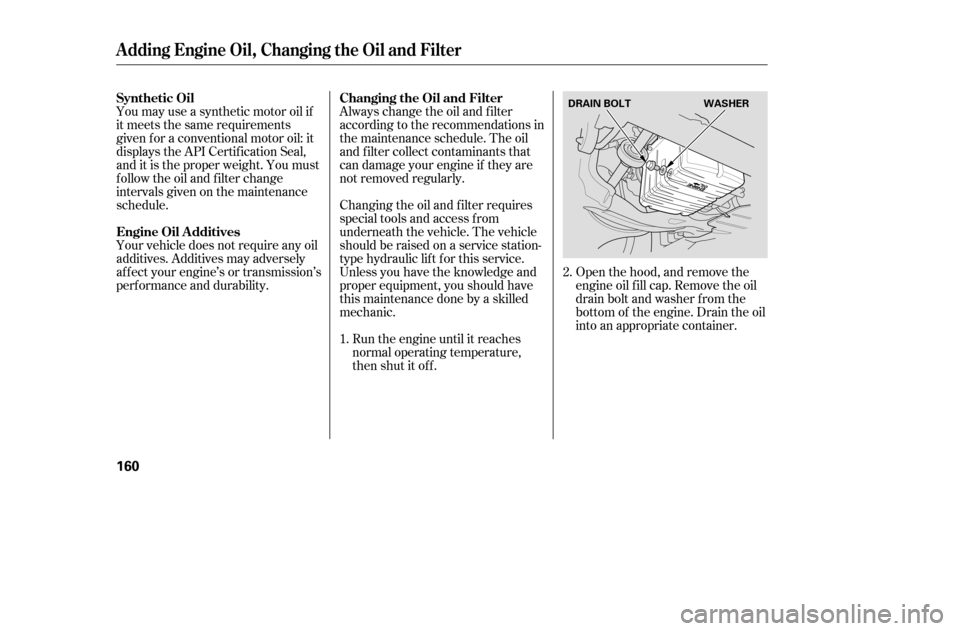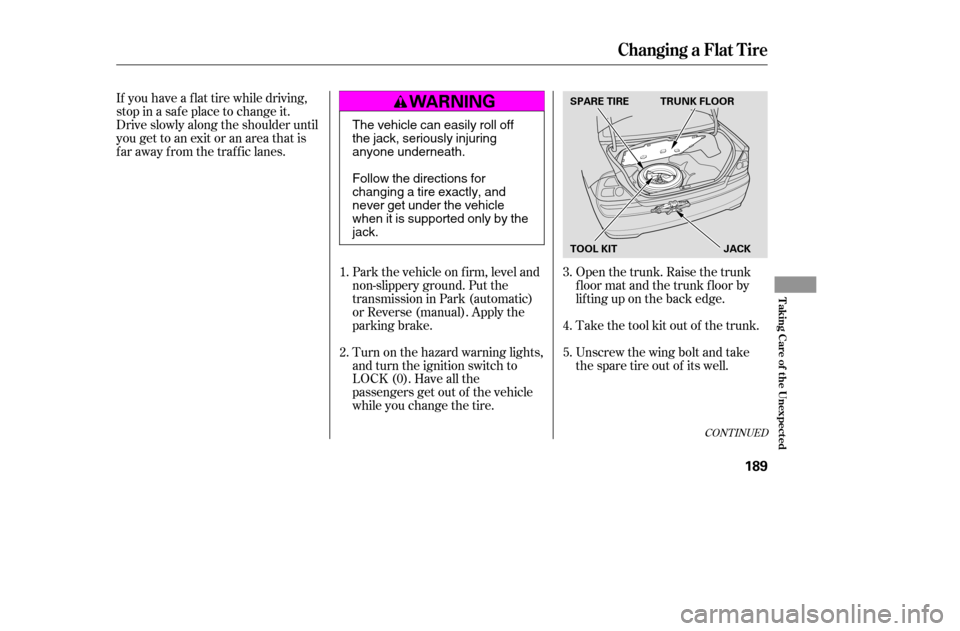Page 150 of 226
Fluid Locations
158
BRAKE FLUID
(Gray cap)WASHER FLUID
(Blue cap)
POWER STEERING
FLUID (Red cap)
AUTOMATIC
TRANSMISSION FLUID
DIPSTICK (CVT)
(Yellow loop)
RADIATOR CAP
ENGINE
COOLANT
RESERVOIR ENGINE OIL DIPSTICK
(Orange loop)
AUTOMATIC
TRANSMISSION
FLUID DIPSTICK
(except CVT)
(Yellow loop) CLUTCH FLUID
(Manual
transmission only)
(Gray cap)
ENGINE OIL
FILL CAP
�����—�����—�����y�
�������������y���
�(���%�������y���
���
�y
Page 152 of 226

Always change the oil and f ilter
according to the recommendations in
the maintenance schedule. The oil
and f ilter collect contaminants that
can damage your engine if they are
not removed regularly.
Changing the oil and f ilter requires
special tools and access f rom
underneath the vehicle. The vehicle
should be raised on a service station-
type hydraulic lif t f or this service.
Unless you have the knowledge and
proper equipment, you should have
this maintenance done by a skilled
mechanic.Run the engine until it reaches
normal operating temperature,
then shut it off. Open the hood, and remove the
engine oil f ill cap. Remove the oil
drain bolt and washer f rom the
bottom of the engine. Drain the oil
into an appropriate container.
You may use a synthetic motor oil if
it meets the same requirements
given f or a conventional motor oil: it
displays the API Certif ication Seal,
and it is the proper weight. You must
f ollow the oil and f ilter change
intervals given on the maintenance
schedule.
Your vehicle does not require any oil
additives. Additives may adversely
af f ect your engine’s or transmission’s
perf ormance and durability.
1.2.
Changing the Oil and Filter
Synthetic Oil
Engine Oil A dditives
A dding Engine Oil, Changing the Oil and Filter
160
DRAIN BOLT WASHER
�����—�����—�����y�
�������������y���
�(���%�������y���
�����y
Page 157 of 226
Check the f luid level with the engine
at normal operating temperature.Park the vehicle on level ground.
Shut of f the engine. Remove the dipstick (yellow loop)
f rom the transmission, and wipe it
with a clean cloth.
Remove the dipstick and check
the f luid level. It should be
between the upper and lower
marks.
Insert the dipstick all the way into
the transmission securely as
shown in the illustration.
NOTE: For accurate results, wait at
least 60 seconds, and no more than
90 seconds, af ter turning of f the
engine to check the f luid level. 3.
4.
1. 2.
CONT INUED
Automatic Transmission Fluid
Maint enance
165
DIPSTICK (A/T)
LOWER MARK
UPPER MARK
DIPSTICK (CVT)
DIPSTICK (A/T)
�����—�����—�����y�
���������
���y���
�(���%�������y���
�����y
Page 158 of 226

If the level is below the lower
mark, add f luid into the f iller hole
to bring it to the upper mark (On
CVT model, the HOT side’s upper
mark).
Remove the dipstick and check the
f luid level. There is a HOT side and a
COLD side on the dipstick. It should
be between the upper and lower
marks on the HOT side. To thoroughly f lush the transmission,
the technician should drain and ref ill
it with Honda ATF-Z1, then drive the
vehicle f or a short distance. Do this
three times. Then drain and ref ill the
transmission a final time.
Insert the dipstick all the way back
into the transmission securely as
shown in the illustration.
If you are not sure how to add f luid,
contact your dealer.
The transmission should be drained
and ref illed with new f luid according
to the time and distance recommen-
dations in the maintenance schedule.
Pour the f luid slowly and caref ully
so you do not spill any. Clean up
any spills immediately; it could
damage components in the engine
compartment.
Always use Honda ATF-Z1
(Automatic Transmission Fluid). If
it’s not available, you may use a
DEXRON
III automatic
transmission f luid as a temporary
replacement. However, continued
use can af f ect the shif t quality.
Have the transmission f lushed and
ref illed with Honda ATF-Z1 as
soon as it is convenient.
5.
6.
On CVT model
Automatic Transmission Fluid
166
UPPER MARK
DIPSTICK (CVT)
LOWER MARK
�����—�����—�����y�
�������������y���
�(���%�������y���
�����y
Page 159 of 226

If Honda MTF is not available, you
may use an SAE 10W-30 or 10W-40
viscosity motor oil with the API
Certif ication seal that says ‘‘FOR
GASOLINE ENGINES’’ as a
temporary replacement. However,
motor oil does not contain the proper
additives, and continued use can
cause stiffer shifting. Replace as
soon as it is convenient.
The transmission should be drained
and ref illed with new f luid according
to the time and distance recommen-
dations in the maintenance schedule.
Check the f luid level with the
transmission at normal operating
temperature and the vehicle sitting
on level ground. Remove the
transmission f iller bolt, and caref ully
f eel inside the bolt hole with your
f inger. The f luid level should be up
to the edge of the bolt hole. If it is
not, add Honda Manual
Transmission Fluid (MTF) until it
starts to run out of the hole. Reinstall
the f iller bolt, and tighten it securely. If you are not sure how to check and
add f luid, contact your dealer.
Manual T ransmission Fluid
Maint enance
167
FILLER BOLT
Correct Level
�����—�����—�����y�
�������������y���
�(���%�������y���
�����y
Page 160 of 226

The f luid level should be between
theMINandMAXmarksontheside
of the reservoir. If the level is at or
below the MIN mark, your brake
system needs attention. Have the
brake system inspected f or leaks or
worn brake pads.The f luid level should be between
theMINandMAXmarksontheside
of the reservoir. If it is not, add
brake f luid to bring it up to that level.
Use the same fluid specified for the
brake system.
Check the f luid level in the brake
f luid reservoir monthly.
Replace the brake f luid according to
the time recommendation in the
maintenance schedule.
Brake f luid marked DOT 5 is not
compatible with your vehicle’s
braking system and can cause
extensive damage.
Using any non-Honda brake f luid can
cause corrosion and decrease the lif e
of the system. Have the brake
system f lushed and ref illed with
Honda Heavy Duty Brake Fluid
DOT 3 as soon as possible.
Always use Honda Heavy Duty
Brake Fluid DOT 3. If it is not
available, you should use only DOT 3
or DOT 4 f luid, f rom a sealed
container, as a temporary
replacement.
A low f luid level can indicate a leak
in the clutch system. Have this
system inspected as soon as possible.
Manual Transmission only
Clutch Fluid
Brake System
Brake and Clutch Fluid
168
MAX
MIN MAX
MIN
�����—�����—�����y�
�������������y���
�(���%�������y���
���
�y
Page 177 of 226

If you need to park your vehicle f or
an extended period (more than one
month), there are several things you
should do to prepare it f or storage.
Proper preparation helps prevent
deterioration and makes it easier to
get your vehicle back on the road. If
possible, store your vehicle indoors.Fill the f uel tank.
Change the engine oil and f ilter. Block the rear wheels.
If the vehicle is to be stored f or a
longer period, it should be
supported on jackstands so the
tires are of f the ground.
Wash and dry the exterior
completely.
Cleantheinterior.Makesurethe
carpeting, floor mats, etc., are
completely dry. Cover the vehicle with a
‘‘breathable’’ cover, one made
f rom a porous material such as
cotton. Non-porous materials, such
as plastic sheeting, trap moisture,
which can damage the paint.
Leave the parking brake off. Put
the transmission in Reverse
(manual) or Park (automatic). Leave one window open slightly (if
the vehicle is being stored
indoors).
If possible, periodically run the
engine until it reaches f ull
operating temperature (the
cooling f ans cycle on and of f
twice). Pref erably, do this once a
month.
If you store your vehicle f or 1 year or
longer, have your dealer perf orm the
inspections called f or in the 2 years/
30,000 miles (48,000 km)
maintenance schedule (Normal
Conditions) as soon as you take it
out of storage (see page ). The
replacements called f or in the
maintenance schedule are not
needed unless the vehicle has
actually reached that time or mileage.
To minimize sticking, apply a
silicone spray lubricant to all door
and trunk seals. Also, apply a
vehiclebodywaxtothepainted
surfaces that mate with the door
and trunk seals.
Support the f ront wiper blade
arms with a f olded towel or rag so
they do not touch the windshield.
Disconnect the battery.
153
Vehicle Storage
Maint enance
185
�����—�����—�����y�
�������������y���
�(���%�������y���
�����y
Page 180 of 226

Park the vehicle on f irm, level and
non-slippery ground. Put the
transmission in Park (automatic)
or Reverse (manual). Apply the
parking brake.
Turn on the hazard warning lights,
and turn the ignition switch to
LOCK (0). Have all the
passengers get out of the vehicle
while you change the tire.Take the tool kit out of the trunk.
Unscrew the wing bolt and take
the spare tire out of its well.
Open the trunk. Raise the trunk
f loor mat and the trunk f loor by
lif ting up on the back edge.
If you have a f lat tire while driving,
stop in a saf e place to change it.
Drive slowly along the shoulder until
you get to an exit or an area that is
far away from the traffic lanes.
5.
4.
3.
2.
1.
CONT INUED
Changing a Flat T ire
T aking Care of t he Unexpect ed
189
SPARE TIRE TRUNK FLOOR
TOOL KIT JACK
The vehicle can easily roll off
the jack, seriously injuring
anyone underneath.
Follow the directions for
changing a tire exactly, and
never get under the vehicle
when it is supported only by thejack.
�����—�����—�����y�
�������������y���
�(���%�������y���
�����y